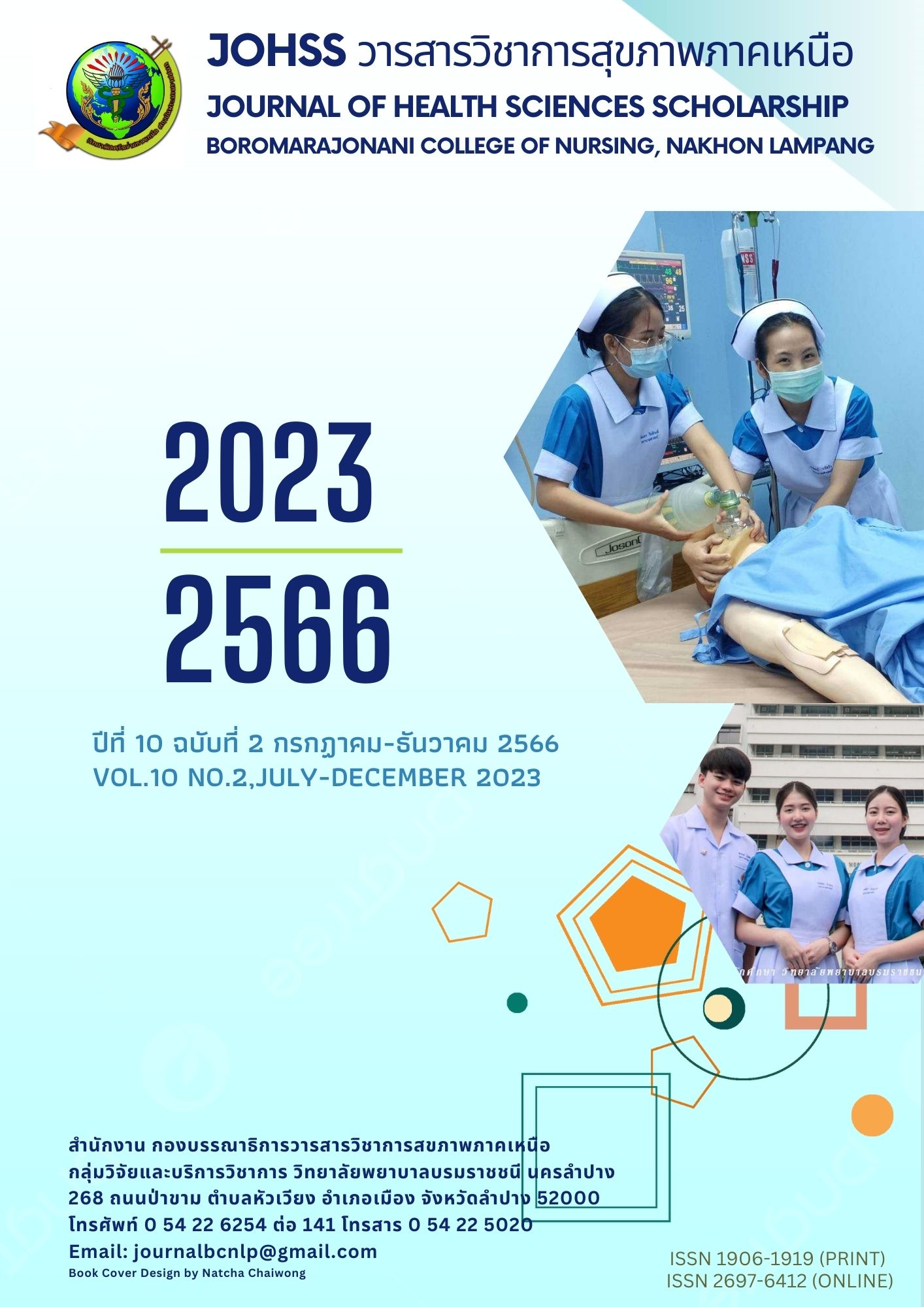พัฒนารูปแบบการสร้างเสริมความรอบรู้ด้านสุขภาพตามหลักพฤติกรรม 3อ 2ส ของผู้สูงอายุโรคเรื้อรังในจังหวัดลำปาง
บทคัดย่อ
การวิจัยเชิงพัฒนานี้มีวัตถุประสงค์เพื่อพัฒนารูปแบบการเสริมสร้างความรอบรู้ด้านสุขภาพตามหลักพฤติกรรม 3 อ 2 ส ของผู้สูงอายุโรคเรื้อรังในจังหวัดลำปาง ผู้ให้ข้อมูลสำคัญและกลุ่มตัวอย่างมี 3 กลุ่มได้แก่ 1) กลุ่มผู้สูงอายุอำเภอเมืองลำปางเพื่อศึกษาความรอบรู้และสถานการณ์สภาพปัญหาความต้องการสร้างเสริมความรอบรู้ด้านสุขภาพตามหลักพฤติกรรม 3 อ 2 ส จำนวน 385 คน 2) กลุ่มพัฒนารูปแบบเป็น ตัวแทนเจ้าหน้าที่สาธารณสุขที่รับผิดชอบงานสร้างเสริมสุขภาพ จำนวน 20 คน และกลุ่มผู้สูงอายุอำเภอเมืองลำปาง 20 คนและ 3) กลุ่มตัวอย่างทดลองประสิทธิผลรูปแบบการสร้างเสริมความรอบรู้ด้านสุขภาพตามหลักพฤติกรรม 3 อ 2 ส ของผู้สูงอายุในอำเภอเมืองลำปาง แบ่งเป็น กลุ่มทดลอง 26 คน และกลุ่มควบคุม 26 คน เครื่องมือที่ใช้ในการวิจัย ได้แก่ 1) แบบสอบถาม ค่าดัชนีความตรงเชิงเนื้อหาอยู่ระหว่าง 0.80 และค่าสัมประสิทธิ์ครอนบาคอัลฟาเท่ากับ 0.83 และ 2) แบบสนทนากลุ่มเพื่อศึกษาสภาพปัญหา และพัฒนารูปแบบ วิเคราะห์ข้อมูลโดยการวิเคราะห์เนื้อหา แจกแจงความถี่และสถิติทดสอบที
ผลวิจัยพบว่า 1) ความรอบรู้และสถานการณ์ปัญหาความต้องการสร้างเสริมความรอบรู้ด้านสุขภาพ ก่อนการใช้รูปแบบมีความรอบรู้อยู่ในระดับปานกลาง (mean=2.12, S.D.= .65) 2) รูปแบบการสร้างเสริมความรอบรู้ด้านสุขภาพตามหลักพฤติกรรม 3 อ 2 ส ของผู้สูงอายุ ได้แก่ 1กิจกรรม การประเมินสุขภาพตนเอง 2.ให้ความรู้เกี่ยวกับโรคเบาหวาน แลกเปลี่ยนเรียนรู้ 3 กิจกรรมกระจกเงาสะท้อนชีวิตเน้นทักษะการสื่อสาร เล่นเกมส์สื่อสาร และ Share & Learn 4.กิจกรรมรู้จักเลือก รู้จักใช้ ทักษะการตัดสินใจฝันให้ไกล ไปให้ถึง และ5 กิจกรรมเราทำได้ ง่ายนิดเดียว เน้นทักษะการการจัดการตนเอง และ3) ประสิทธิผลผลของโปรแกรม พบว่าหลังการใช้รูปแบบผู้สูงอายุมีความรอบรู้ทางสุขภาพและพฤติกรรม3 อ 2 ส กลุ่มทดลองมีคะแนนเฉลี่ยความรอบรู้ด้านสุขภาพ, คะแนนเฉลี่ยความรอบรู้ด้านสุขภาพ พฤติกรรมสุขภาพและค่าเฉลี่ยน้ำตาลสะสม ดีกว่าก่อนทดลอง อย่างมีนัยสำคัญทางสถิติที่ระดับ 0.05 ส่วนกลุ่มควบคุมพบว่าไม่มีความแตกต่างกันอย่างมีนัยสำคัญ
เอกสารอ้างอิง
Bains, S.S. (2011). Egede LE.Associations between health literacy, diabetes knowledge, self-care behaviors, and glycemic control in a low income population with type 2 diabetes. Diabetes Technol. Ther.,13(3):335-41.
Bandura, A. (1977). Self-efficacy: Toward a unifying theory of behavioral change. Psychological Review, 84 (2), 191-215.Berkman ND, Davis TC, Mccormack L. (2010). Health literacy: What is it?,Journal of Health Communication. 15, 9-19.
Padwang, B., Wannalai, U., Iamsumang Jaramillo, W. (2023). Relationships between Health Literacy and 3E 2S Health Behavior of the Elderly with Diabetes in Mueang Lampang District, Lampang Province. Journal of Health Sciences Scholarship,10 (1) 213- 228.
De Walt D, Berkman N, Sheridan S, Lohr K, Pignone M.(2004). Literacy and health outcomes. J Gen Intern Med,19:1228-39.
Division of Health Education Department of Health Service Support Ministry of Public Health. (2018). Building and assessing health literacy and health behaviors. (revised version). Nonthaburi: Ministry of Public Health. (In Thai)
Division of Non-Communicable Diseases, Department of Disease Control, Ministry of Public Health. (2021) .Annual Report 2021. Department of Disease Control, Division of Non-Communicable Diseases, Prevention and Control of Chronic Non-Communicable Diseases in Thailand. Graphic and Design Publishing House, Nonthaburi. (In Thai)
Duangthipsirikul, S. (2013). Research report, 2013 Thai Elderly Health Survey under the Elderly and Disabled Health Promotion Program. Nonthaburi: Elderly Health Group Bureau of Health Promotion, Department of Health, Ministry of Public Health. (In Thai)
Friis, K., Vind, B.D., Simmons, R.K., & Maindal, H.T. (2016).The relationship between health literacy and health behaviour inpeople with diabetes:a Danish population-based study. J Diabetes Res, 1-7.
Ginggeaw, S., Prasertsri, N. (2015). The relationship between health literacy and health behaviors among older adults who have multi-morbidity. Nursing Journal of Ministry of Public Health, 25(3):43-54. (in Thai).
Indrakamhang, U. (2017). Complete Report on Creating and Developing of Thailand Health Literacy Scales, Division of Health Education. Department of Health Service Support Ministry of Public Health. (In Thai)
Ishikawa, H., Takeuchi, T., & Yano, E. (2008). Measuring Functional, Communicative, and Critical Health Literacy among Diabetic Patients. Diabetes Care, 31(5), 874-879.วารสารวิชาการสุขภาพภาคเหนือ ปีที่ 10 ฉบับที่ 2 กรกฎาคม-ธันวาคม 2566Journal of Health Sciences Scholarship July-December 2023, Vol.10 No.2
Kim, SH. (2009). Health literacy and functional health status in Korean older adults. J Clin Nurs, 18:2337–43.
Lampang Provincial Public Health Office. (2021). Official statistics registration system. population by age Lampang Province: Lampang Provincial Public Health Office. (In Thai)
Meebunmak, Y. (2019). Health literacy of the elderly in a semi-urban community in Ratchaburi Province. The Southern College Network Journal of Nursing and Public Health. 6 (Special Issue), 129-141. (In Thai)
National Statistical Office, (2020). The 2020 survey of the older persons in Thailand. Bangkok: Text and Journal Publication. (In Thai)
Nutbeam, D. (2008) The evolving concept of Health literacy. Soc Sci Med, 67:2072-8.
Osborn, C. Y.,Paasche-Orlow, M.K., Bailey,S.C., & Wolf, M.S. (2011).The mechanisms linking health literacy to behavior and healthstatus. Am J Health Behav, 35(1):118-28.
Parker, R.M. (2000). The Health literacy: A challenge for American patients and their health care providers. Health Promot. Int., 15:277-91.
Singsem, P., Krainara, P., & Thiprat, W. (2019). Study of the relationship between health literacy and health behaviors according to 3O.2S. of the elderly in Nong Trut Subdistrict, Trang Province. The health literacy level of the elderly was not good. Journal of Boromarajonani College of Nursing Uttaradit, 11(1) 37-51. (In Thai)
World Health Organization, (1998). Health Promotion Glossary. Division of Health Promotion, Educationand Communications, Health Education and Health Promotion Unit. Geneva: World Health Organization.
ดาวน์โหลด
เผยแพร่แล้ว
ฉบับ
ประเภทบทความ
สัญญาอนุญาต
ลิขสิทธิ์ (c) 2023 วิทยาลัยพยาบาลบรมราชชนนี นครลำปาง

อนุญาตภายใต้เงื่อนไข Creative Commons Attribution-NonCommercial-NoDerivatives 4.0 International License.
บทความ ข้อมูล เนื้อหา รูปภาพ ฯลฯ ที่ได้รับการตีพิมพ์ในวารสารวารสารวิชาการสุขภาพภาคเหนือ ถือเป็นลิขสิทธิ์ของวารสารวารสารวิชาการสุขภาพภาคเหนือ หากบุคคลหรือหน่วยงานใดต้องการนำทั้งหมดหรือส่วนหนึ่งส่วนใดไปเผยแพร่ต่อหรือเพื่อกระทำการใดๆ จะต้องได้รับอนุญาตเป็นลายลักอักษรจากวารสารวารสารวิชาการสุขภาพภาคเหนือก่อนเท่านั้น
เนื้อหาและข้อมูลในบทความที่ลงตีพิมพ์ในวารสารวิชาการสุขภาพภาคเหนือถือเป็นข้อคิดเห็นและความรับผิดชอบของผู้เขียนบทความโดยตรงซึ่งกองบรรณาธิการวารสาร ไม่จำเป็นต้องเห็นด้วย หรือร่วมรับผิดชอบใดๆ
อนึ่ง ข้อความและข้อคิดเห็นต่างๆ เป็นของผู้เขียนบทความนั้นๆ ไม่ถือเป็นความเห็นของวารสารฯ และวารสารฯ ไม่จำเป็นต้องเห็นด้วยกับข้อความและข้อคิดเห็นใดๆ ของผู้เขียน วารสารฯ ขอสงวนสิทธิ์ในการพิจารณาตีพิมพ์ตามความเหมาะสม รวมทั้งการตรวจทานแก้ไขหรือขัดเกลาภาษาให้ถูกต้องตามเกณฑ์ที่กำหนด



